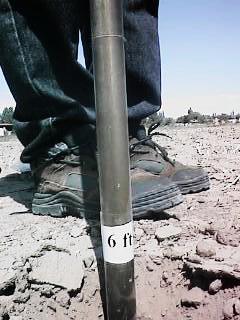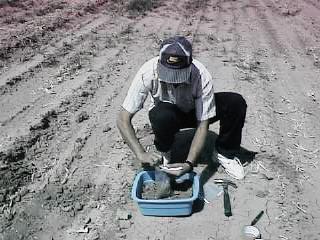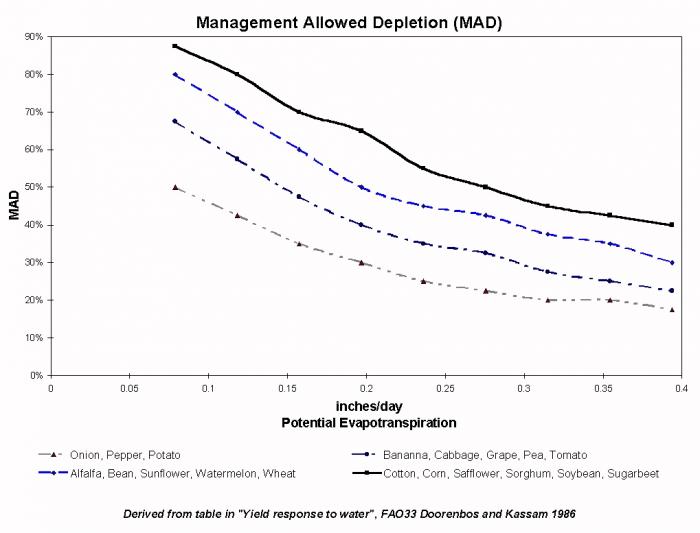Irrigation Scheduling Instructions
Field Evaluation of Efficiency
Methodology
Irrigation Efficiency and Nitrogen Loading to the Ground Water
Irrigation water and nitrogen are inputs to grow any crop in New Mexico and excess water application leaches nitrogen to the ground water. Excess nitrogen application also results in loss of nitrogen into the ground water. Chloride naturally occurs in the irrigation water in the western United States including New Mexico and can be used as a tracer to determine irrigation efficiency and the amount of nitrogen being leached below the root zone. Chloride can not be used as a tracer on soil that in the weathering process produces large amounts of chloride.
The information needed to calculate the irrigation efficiency are:
- The chloride content in the irrigation water.
- The chloride content in the soil below the root zone of the crop
- The moisture content of the soil sample below the root zone being analysised for chloride content
- The yield of the crop
- The soil type i.e. sand , loam or clay.
If nitrogen loading to the ground water is desired to be determined, the soil samples taken below the root zone need to be analysised for nitrogen content.
Field Data Collection
Irrigation Efficiency and Nitrogen Loading to the Ground Water
- Should be taken a three times during the growing season and sent to a Soil Water Testing Laboratory and analyzed for chloride content.
Soil samples below the root zone can be collected at the time soil samples are acquired for fertilization recommendations, usually during the winter or before planting in the spring. Soil samples need to be collected below the root zone in 1 ft increments using a 2 or 3 inches soil bucket auger that can be acquired from Soil Moisture Equipment or other supplier of soil moisture sampling equipment. Take the field and divided the length into quarters and sample from each quarter. The soil sample should be put into a plastic bag and labeled for field name, location in field, crop grown, date taken and depth i.e. 3ft, 4ft, .....8ft. Ideally 4 samples should be taken at each location mixed thoroughly and a subsample of that composite sample put in the plastic bag. If this is not possible then collect soil from only one soil auger hole. Samples taken in the root zone of the crop can not be used to calculate irrigation efficiency and nitrogen loading to the ground water. Soil Samples taken below the root zone should be labeled and sent to the same laboratory that the water sample has been sent and the soil samples analyzed for moisture content, nitrogen and chloride content. Because the soil sample is analyzed for moisture content, it is important to seal the bag to make it is air tight. Because the soil sample is analyzed for moisture content, it is important to seal the bag to make it is air tight. Soil type should be determined using the

or soil settling method. Yield data should be acquired for the crop from the farmer.

The auger can be marked in 1 ft increments using masking tape. The handle of the auger can have extensions added on it so that the first four ft. are dug with a 4 ft. auger and then the extension added to dig the lower depths. This is a safety issue. Turning the auger when it is above your head can cause shoulder muscles to be torn.

Theory (Equations)
Irrigation Efficiency and Nitrogen Loading to the Ground Water
Theory of using chloride as a tracer to calculate Irrigation Efficiency and Nitrogen Loading to the Ground Water
Theory of the Chloride Technique: Chloride in the irrigation water is either taken up by the crop or remains in the soil water. Since chloride is not adsorbed or released by most soil, the ratio of Cl- concentration in irrigation water to Cl- concentration in drainage water can be used to estimate the irrigation leaching fraction (LF) (Pratt et al., 1978). Leaching fraction is defined as the fraction of irrigation water applied to the field that leaches below the root zone. It is calculated as :
excluding rainfall (M. Salameh Al-Jamal, T. W. Sammis and T. Jones. 1997)
including rainfall
where :
Et is the seasonal evapotranspiration (kg H2O/ha). Cli is the chloride concentration (kg Cl- / kg H2O) in the irrigation water, Clp is the chloride concentration (kg Cl-/kg H20) in the soil water below the root zone, Clc is the amount of chloride taken up by the crop (kg Cl- /ha). Vr=volume of rainfall (kg H2O/ha) Clr= chloride concentration (kg Cl- / kg H2O) in the rainfall water The cumulative drainage flux density (Vp) in kg/ha is estimated as:
Vp= LF * Et/ (1-LF) (Eq 2)
The amount of chloride (kg/ha) in the total applied water ( Cla )is calculated by knowing the concentration of chloride in the irrigation water(Cli) and rainfall (Clr), the volume of irrigation water (Vp/LF- Vr) and rainfall (Vr), and the amount taken up by the crop (Clc) as expressed by Eq. 3:
Cla = Cli* (Vp/LF- Vr)+Vr*Clr- Clc (Eq 3)
The amount of nitrogen (kg/ha) leaching to the ground water ( Np ) is calculated as:
Np= Cla *NO-3-Ns / Cls (Eq 4)
where NO-3-Ns is concentration in the soil (mg NO-3-Ns /mg soil) and Cls is the chloride ion concentration in the soil (mg Cl- /mg soil).
The method assumes steady-state conditions where the root zone water storage is constant over time. However, under field conditions steady-state conditions may be difficult to achieve, especially if light, and frequent irrigation practices are not used (Olson, 1978). The assumption that chloride is not adsorbed may also be invalidated . For example, if anion exchange reactions occur between the soil and Cl- in the irrigation water or if Cl- precipitation occurs , then the Cl- balance could be off unless these Cl- sources or sinks are accounted for (Stewart 1978).
References
- Olson, R.A. 1978. Critique of "An approach to measuring leaching of nitrate from freely drained irrigated fields." In D.R. Nielsen and J.G. Mac Donald (ed.). Nitrogen in the environment. Vol. 1. Nitrogen behavior in field soil. Academic press. Pp. 257-265.
- Pratt, P.F., L.J. Lund, and J.M. Rible. 1978. An approach to measuring leaching of nitrate from freely drained irrigated fields. In D.R. Nielsen and J.G. Mac Donald (ed.). Nitrogen in the environment. Vol 1. Nitrogen behavior in field soil. Academic Press. Pp. 223-265.
- Stewart, B. A. 1978. Critique of "An approach to measuring leaching of nitrate from freely drained irrigated fields." In D. R. Nielsen and J. .G. Mac Donald ed. Nitrogen in the environment ... Vol. 1. Nitrogen behavior in field soil. Academic press. P.267-273
- M. Salameh Al-Jamal, T. W. Sammis and T. Jones. 1997. Nitrogen and chloride concentration in deep soil cores related to fertilization. Ag. Water Management 34:1-16
Tensiometer Use To Schedule Crop Irrigation
Ted Sammis Irrigation Specialist New Mexico State University High yields are achieved by irrigating at the proper time. When furrow irrigating there is a trade off between the time to irrigate and the level of irrigation efficiency obtained. The soil is a reservoir that contains available water that the plant can deplete. The level of water that can be depleted before the plants show a large amount of stress is when the readily available water has been depleted. The available water is the water held in the soil between field capacity and permanent wilting point. The amount of water that can be depleted is call the Management Allowed Depletion (MAD) which varies from 30 percent of the available water to 60 percent.
An irrigation scheduling model calculates a water budget that keep track of the available moisture and recommends an irrigation at the time the depletion level is reached. As the roots increase in length into the soil profile, the amount of available water in inches that can be depleted before an irrigation occurs increases. However, the rate of withdraw also increases as the root depth increases and the plant cover increases. The rate of withdraw also increases as the climate changes with increasing temperature and solar radiation. See the extension publication from Colorado State University for a complete explanation of the water budget approach.
The water budget approach determines the depletion level for the whole root zone. If a tensiometer is used to schedule irrigation's, then it must be placed in the portion of the root zone that represent the same depletion level as the average depletion level calculated using the water budged approach. The general depletion levels are: (1) 40 percent of the water used by the crop is extracted from the first quarter of the root zone (2) 30 percent is extracted from the second quarter (3) 20 percent is extracted from the third quarter and (4) 10 percent is taken from the last quarter of the root zone. Consequently, a tensiometer needs to be placed between the second and third quarter of the root zone or at 63 percent of the depth of the roots in order for it to be placed in the depth of the root zone representing the average extraction level. As an example, if the root zone is 36 inches the tensiometer should be placed at 23 inches, or two feet. The irrigation should occur when the selected MAD is reached. The tensiometer reading is different for different soils to reach the same MAD. In order to convert from the selected MAD to a tensiometer reading use
To determine the MAD for different crops see the Table 1 by Sanders 1993
Table 2 by AlKaisi and Broner Crop Water Use and Critical Growth Stages or Figure 2

(Doorenbos and Kassam 1986). Sanders presents the level of Available Soil Moisture (ASM) that must be in the soil at the time of irrigation. The MAD is equal to 1 - ASM. Irrigating when the soil moisture has decreased below the MAD causes the crop to be under
and yield. The depth of the roots for selected crops is also given by Sanders 1993. Vegetable Crop Irrigation The rooting depth is highly dependent on local conditions and should be determined for a site by using a shovel and digging up the plants at selected times during the growing season. Generally, the plants will reach their maximum root depth when plant cover reaches a maximum. The tensiometer needs to be lowered as the root depth increases, or two or three tensiometers need to be installed and the tensiometer used to schedule irrigation's should be the one closes to 63 percent of the root zone depth at the time of scheduling irrigation's.
As can be observed from figure 1, tensiometers work best in sandy or sandy loam soil because they break suction and quit working when the soil tension exceeds 80 cbars.
An example of how to use a tensiometer follows:
- Soil type sandy loam
- Crop onions
- MAD 30 percent
- Rooting depth 12 to 18 inches select 12
- Depth of tensiometer .63*12= 8 inches after cover is 70-80 percent before then use 4 inches
- Tensiometer reading at irrigation using figure 1 is 20 cbar